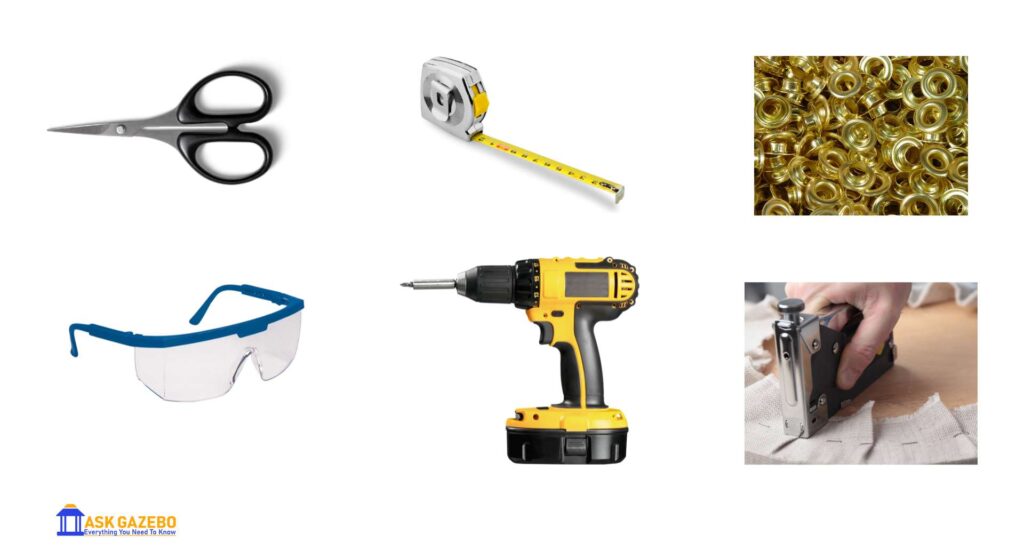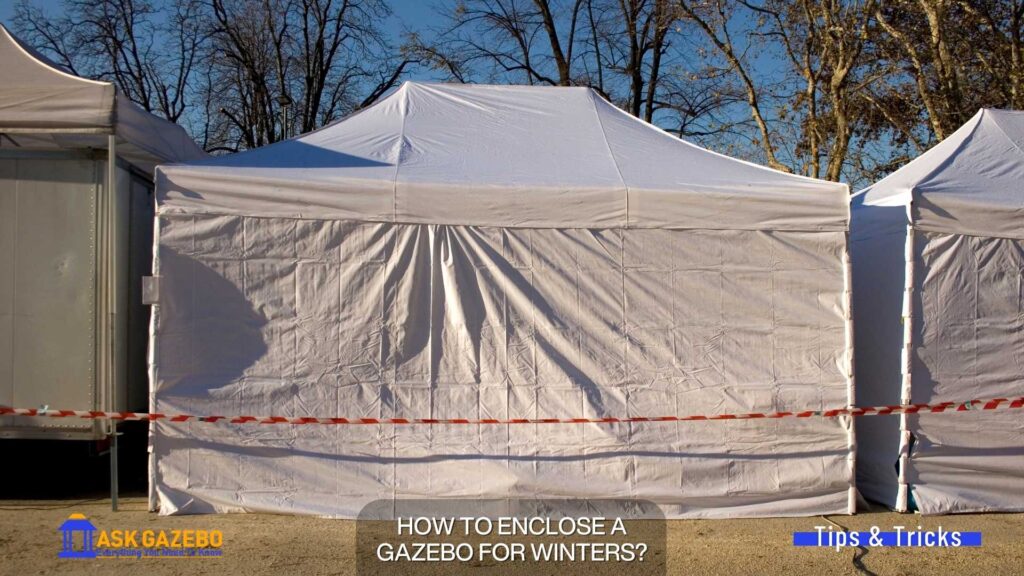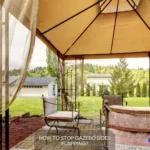Enclosing a gazebo for the winter extends its use and protects it from harsh weather conditions. It not only gives a comfortable and secure area to relax but also guards against harm to the gazebo itself.
This article will offer detailed directions and a step-by-step guide for enclosing a gazebo for winter as well as advice on how to care for it over the winter. So, grab your gear and be with us to learn how to enclose a gazebo for winter.
Why Enclose a Gazebo For Winter?
There are several benefits of enclosing a gazebo for winter:
Extend the use of the gazebo: Although gazebos are frequently utilized as outdoor living areas, bad weather during the winter can prevent their use. But enclosing a gazebo for winter will extend its use.
You can use the gazebo as a cozy and secure area by enclosing it even when the weather gets chilly. It enables you to utilize your gazebo more frequently throughout the year, which can be especially handy if you reside in a location with lengthy, severe winters.
Protect the Gazebo: Another benefit of enclosing a gazebo for winter is the ability to protect it from harmful elements. The common materials used to construct gazebos are wood or metal, which can get damaged from wind, snow, and other severe weather events.
The gazebo’s lifespan can be increased by adding a layer of protection from these factors by enclosing it. Additionally, it can shield the gazebo from additional types of harm like rotting, fading, and discoloration that can result from extended exposure to the sun and other environmental factors.
Increase privacy: Enclosing a gazebo can also increase privacy. Gazebos might be less private because they are frequently placed in public spaces or near property boundaries. Enclosing the gazebo can create a more private and quiet area for you to relax and enjoy time with friends and family.
This can be extremely helpful if you live in a more populated region or have a large yard.
Tools you need to Enclose a Gazebo:
To enclose a gazebo for winter, you will need a few tools to ensure the job is done properly. Here is more information about each of the tools you need:


- Measuring tape: To accurately determine your gazebo’s dimensions and calculate the needed material. Ensure you have enough fabric to completely cover the gazebo by measuring its width, length, and height.
- Scissors or a utility knife: You will require a sharp tool to cut the enclosure material to size. For this, scissors or a utility knife will work fine, but always exercise caution when working with anything sharp.
- Grommets, ties, or bungee cords: These tools will be used to attach the gazebo frame and enclosure material together. Wrap bungee cords or ties around the frame to tighten the material and fix it in place. Grommets, which are tiny metal rings that can be applied to the fabric and fastened to the frame with screws or staples, offer an alternative.
- Screwdriver or stapler: The enclosing material can be fixed to the gazebo structure with screws or a stapler. The material can be connected with a stapler, although screws might be more dependable and long-lasting.
- Safety glasses: When using power tools like a drill or stapler, it’s crucial to safeguard your eyes. To save your eyes from flying debris, put on safety goggles.
You will also need the enclosure material and any extras you add, such as heaters or blankets, in addition to this equipment. Before you start enclosing your gazebo, make sure you have all the required tools and materials on hand.
Also, Learn:
· How to enclose a gazebo with screens or with plexiglass.
· How To Enclose a Metal Gazebo
· How To Secure A Gazebo From Wind?
Things to Keep in Mind While Enclosing a Gazebo:
There are a few important things to keep in mind when enclosing your gazebo to ensure the job is done properly, and the gazebo is well protected.
Here are some things to consider:
- Choose a durable, weather-resistant fabric: The material used for the enclosure should be resistant to weather conditions such as wind, rain, snow, and ice. Polyethylene and canvas are resistant to UV rays, wind, and water, making them wise choices.
- Measure carefully: For the enclosure material to fit properly and completely enclose the gazebo, accurate measurements are necessary, even if you are doing it for the first time. A few inches of mis-measurements to the gazebo’s width, length, and height measurements can give the cold air a path to come inside.
- Secure the material properly: To keep the enclosure material from blowing off in heavy winds, the gazebo frame should be firmly secured to the enclosure material. To secure the material to the frame, connect it with screws or staples after securing it with bungee cords, ties, or grommets.
- Leave enough ventilation: To avoid condensation and mold growth, adequate ventilation must be left. Completely enclose the gazebo but leave a small opening at the top for ventilation that you can easily open.
- Check for damage regularly: It’s crucial to inspect the enclosure for rips or other damage routinely. To keep the gazebo safe from the weather, fix any problems right away.
These tips will help you ensure your gazebo is adequately covered and weatherproof so you can use it throughout winter.


How To Enclose A Gazebo For Winters?
Here are the right steps to completely enclose your gazebo to protect it from winter cold:
Step 1:
Measure the exact dimensions of your gazebo. It will give you an idea of how much fabric you need.
After this, ensure you have enough fabric to cover the entire gazebo. Also, remember the overlap and securing methods you will use when choosing your material.
You can also cut your fabric into pieces, like one for each side and one or two pieces for the roof.
Step 2:
Pick a strong, weatherproof material, such as polyethylene or canvas. These materials are suitable for enclosing a gazebo since they resist wind, water, and UV ray damage.
Use durable materials instead of those that are prone to fading or tearing because these might not keep up well over time.
Step 3:
Cut the material to the appropriate size, leaving some extra for securing and overlapping. To guarantee a good fit, carefully measure and cut the material.
Step 4:
The material should be secured to the gazebo structure with grommets, bungee cords, or ties. Pulling the fabric tight as you go, fasten the cords or ties to the gazebo’s structure.
Alternatively, you could use grommets to fasten the fabric to the frame. You could then use screws or staples to keep it in place.
Step 5:
Use a staple gun or screws to attach the material to the frame, starting at the bottom and working your way up.
To achieve a stronghold, ensure the staples or screws are applied uniformly.
Step 6:
Ensure there is enough ventilation to ward off moisture and mold development. Completely enclose the gazebo, but leave a small opening at the top for ventilation. This will lessen the chance of moisture and mold formation, which could harm the gazebo and the material used for the enclosure.
You can easily enclose your gazebo and use it throughout the winter by following these instructions.
Do you know How Much Weight Can A Gazebo Hold or Does A Gazebo Increase Home Value?
Tips for maintaining your enclosed gazebo:
Your gazebo can be extended in use and protected from the weather by being enclosed for the winter, but regular maintenance is necessary to keep it in good shape.
Here are some suggestions for keeping your covered gazebo in good shape:
- Regularly check the forecast and clear the section of any snow or ice buildup. This will lessen the risk of harm to the gazebo frame and enclosing material.
- To keep the gazebo from being exposed to the weather, immediately fix any tears or holes you find in the enclosure material.
- It is a good idea to remove the enclosure and store it in a dry location when the gazebo is not in use.
- The enclosure material may become dirty over time, resulting in fading and discoloration. Regularly clean the enclosure with a light detergent and a soft brush to keep it looking its best.
Practicing these suggestions will help you maintain your enclosed gazebo and it will continue to offer you a warm, safe environment to enjoy all winter long.


Subscribe For More Gazebo Videos!
Ask Gazebo
FAQs
Some frequently asked questions people ask about enclosing a gazebo for winter:
What kinds of materials are ideal for gazebo enclosures?
For enclosing a gazebo, polyethylene or canvas are suitable options because they are strong and resistant to UV, wind, and water damage.
Instead of these, you can also use any thick or sturdy material to cover up your gazebo. Thick materials will not let cold pass easily and you will get a comfy and warm gazebo inside.
Can I enclose my own gazebo?
Most people can complete the very straightforward DIY job of enclosing a gazebo on their own. You should be able to properly enclose your gazebo as long as you have the necessary supplies and tools and pay close attention to the up directions.
How can I keep the gazebo from condensing and developing mold?
To avoid humidity and mold growth inside the gazebo, it’s crucial to leave ample airflow. Completely enclose the gazebo, but remember to leave a small opening at the top for ventilation.
You can open the ventilation hole once a month or a week for better air quality inside the gazebo. It will protect your gazebo from developing mold.
How to enclose a metal gazebo for winter?
You can enclose your metal gazebo for winter as we shared the steps above. First, get the right tools, and measure the length of the fabric you need. Once you have the right fabric length, start from below and keep fixing it with the metal frame.
For fixing the fabric with a metal structure, you can tie it or can utilize cords. Make sure you are fixing it right so that it couldn’t lose up easily.
How To Enclose A Gazebo With Screen?
Enclosing a gazebo with a screen requires careful planning and execution to achieve desired results. First, determine the exact size of the gazebo by measuring its height, width, and depth, and note any angles or curves.
Cut the screen material to size based on these measurements, and put the screen frame together using fasteners, ensuring all screws and bolts are tight for strength.
Finally, attach the screen material to the frame, ensuring it is smooth and wrinkle-free for a neat and professional appearance. Check this dedicated guide.
Are you tired of birds in your gazebo? Learn: How To Keep Birds From Nesting in Gazebo?
Conclusion:
To enclose your gazebo, follow the instructions in this article, and be sure to maintain it correctly to keep it in good shape.
Make sure you have the exact measurements of your gazebo and the fabric to cover it with. After getting the right measurements, cut the fabric to the exact length so that it can get fit perfectly.








